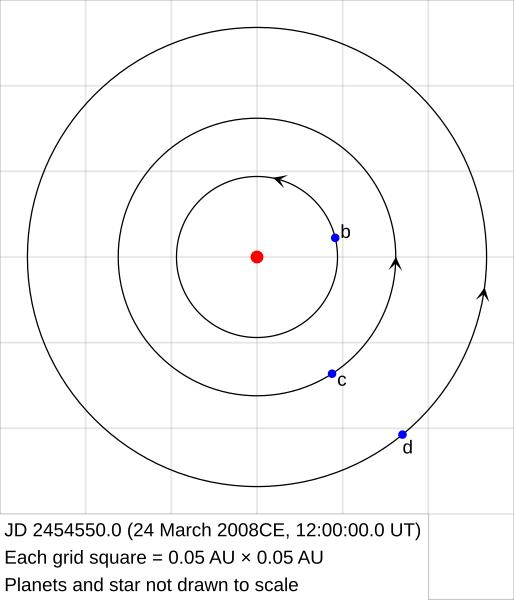File:HD40307.svg

Original file (SVG file, nominally 636 × 742 pixels, file size: 4 KB)
Captions
Captions
This file requires updating. In doing so, you could add a timestamp to the file.
|
Summary[edit]
| DescriptionHD40307.svg |
English: Summary
SVG image of the HD 40307 system orbits. The orbital parameters are taken from Mayor et al. (2008), arXiv:0806.4587v1 (astro-ph) "The HARPS search for southern extra-solar planets. XIII. A planetary system with 3 Super-Earths (4.2, 6.9, & 9.2 Earth masses)", Table 2. Assumptions:
Interpreting the diagram The planetary orbits are drawn in orthographic projection, as viewed from directly above the plane of the system so that the orbital direction is anticlockwise. The position of each planet in its orbit is calculated using the time of periastron in the table in the Mayor et al. paper, and are drawn at a time near the end of the radial velocity data (figure 3 in the paper). This time is chosen so that the effects of both uncertainties in the orbital parameters and potential orbital evolution of the system can be treated as negligible. While the orbits are drawn to the correct scale on the diagram, the star and the planets themselves are not shown to scale. |
| Source | Own work |
| Author | Icalanise |
Licensing[edit]
| Public domainPublic domainfalsefalse |
| I, the copyright holder of this work, release this work into the public domain. This applies worldwide. In some countries this may not be legally possible; if so: I grant anyone the right to use this work for any purpose, without any conditions, unless such conditions are required by law. |
File history
Click on a date/time to view the file as it appeared at that time.
| Date/Time | Thumbnail | Dimensions | User | Comment | |
|---|---|---|---|---|---|
| current | 15:32, 14 November 2010 |  | 636 × 742 (4 KB) | Icalanise (talk | contribs) | Added direction arrows and descriptions in source code. |
| 14:30, 30 October 2008 |  | 636 × 742 (3 KB) | Icalanise (talk | contribs) | {{Information |Description={{en|1=<b>Summary</b> SVG image of the HD 40307 system orbits. The orbital parameters are taken from [][astro-ph] "The HARPS search for southern extra-solar planets. XIII. A planetary system with 3 Super-Earths (4.2, 6.9, & 9.2 |
You cannot overwrite this file.
File usage on Commons
The following 2 pages use this file:
File usage on other wikis
The following other wikis use this file:
- Usage on en.wikipedia.org
- Usage on id.wikipedia.org
- Usage on ja.wikipedia.org
- Usage on ko.wikipedia.org
- Usage on pl.wikipedia.org
- Usage on ru.wikipedia.org
- Usage on tr.wikipedia.org
- Usage on uk.wikipedia.org
- Usage on zh.wikipedia.org
Metadata
This file contains additional information such as Exif metadata which may have been added by the digital camera, scanner, or software program used to create or digitize it. If the file has been modified from its original state, some details such as the timestamp may not fully reflect those of the original file. The timestamp is only as accurate as the clock in the camera, and it may be completely wrong.
| Short title | Orbits of the HD 40307 system |
|---|